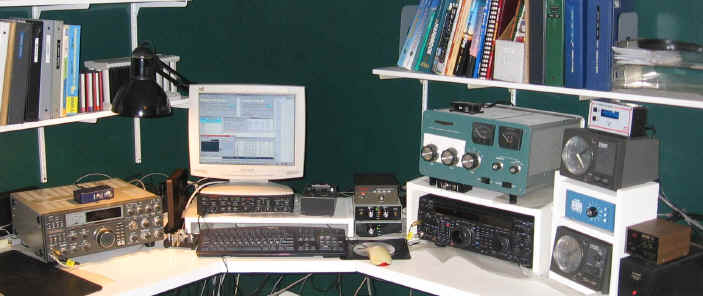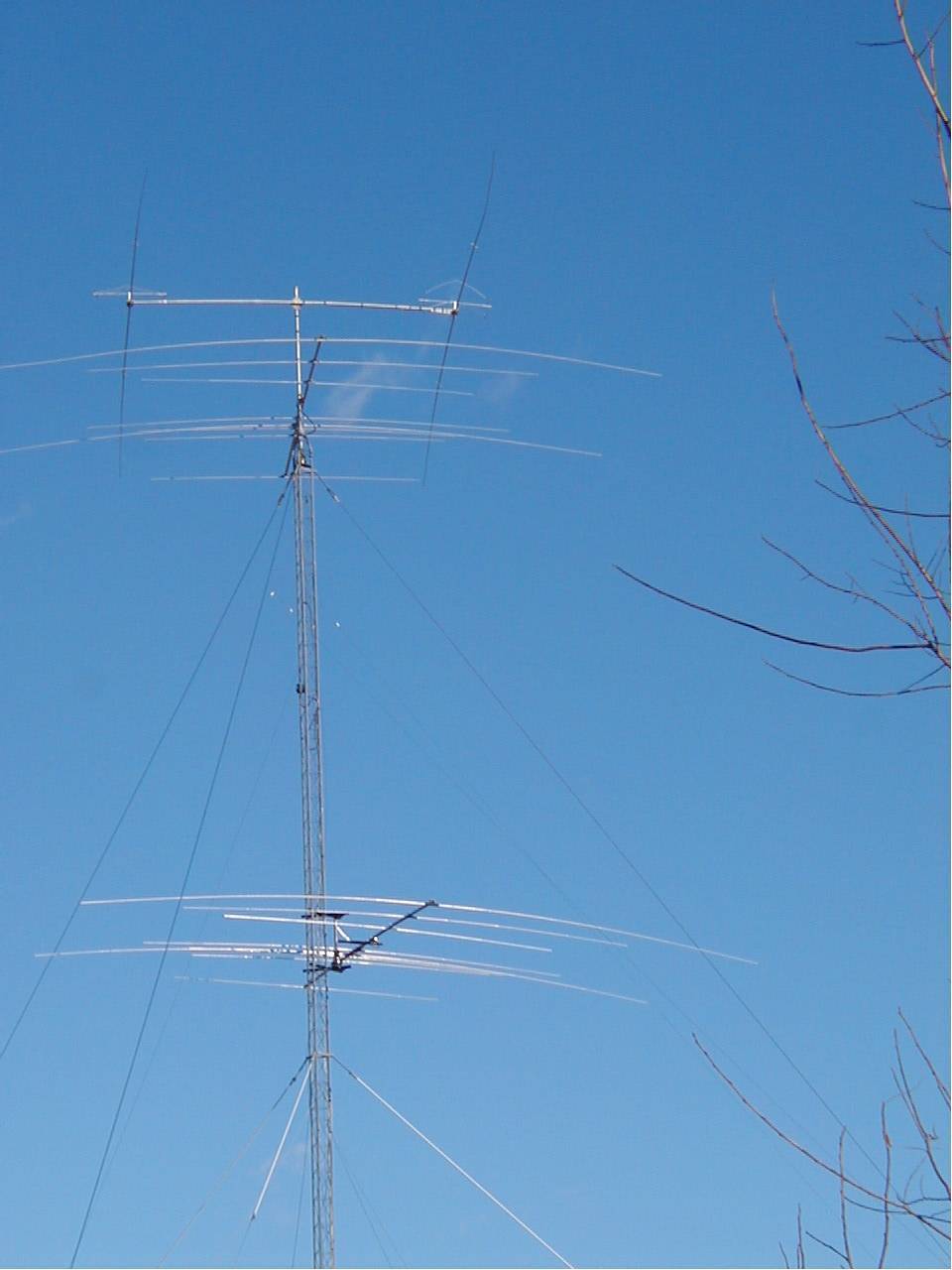
N4ZR -- "Radio Free West Virginia"

This is my station, as of February 5, 2008. There's been a lot of change since I last updated this page, and frankly, I'm really pleased with how the new operating position turned out. This is probably about as good as it's going to look, even though there is still wax paper under most everything to give the paint a little more time to dry.
Because my station is in one corner of a spare bedroom, which must still be available for guests, there isn't enough room for the ideal operating desk, which would have access from the back. My first thought was to put the whole thing on wheels, but it quickly became clear that would be disastrous for the carpeting and structurally dubious as well.
Then I realized that placing my station in the corner inevitably creates a "dead space" in the back corner of the operating desk. In a brainstorm, I decided that I could make a triangular opening there which would be large enough to afford me access to at least some of the backs of my equipment, as well as the computer (which "lives" under the desk).
The resulting operating desk was built from two flush panel hollow wood doors, each 30 inches wide by 78 inches tall. A triangular section was cut out of one door to create the access opening, while the other door was cut down to 48 inches and mounted perpendicular to the first. The rear edges of the doors were mounted to the wall, while the two ends are supported on salvaged kitchen cabinet units with three drawers each, which have survived four different operating positions to date.
To stiffen the structure in the center, where the monitor and computer would be, as well as the areas where the radios would be, I mounted a 2 x 4" wood brace diagonally across the "L" from one wall to the other. And finally, as a finishing touch, I mounted part of the triangular piece that had been cut out of one door in the center of the "L" to provide some extra width for the keyboard.
The resulting desk is extremely stiff. I can crawl under and then sit up in the access hole The resulting access to the computer and the switching equipment in the middle is fine, though it leaves something to be desired for access to the radios.
Another design idea left over from the previous station helps solve that problem. Where I need to arrange equipment in more than one vertical layer, I've taken to using individual, portable structures. These have metal or nylon "feet" on them, so that even when fully loaded, they slide readily on the desktop. This way, I can rearrange equipment to accommodate new items, or new ideas about how to lay things out. And when I need to work on one or another, I can easily slide them toward the front edge of the operating table and turn them so that their backs face toward the access hole.
To the left is my TS-930. It continues to do yeoman service as my second radio for SO2R, and also gets lugged out to the base of the tower when I need to tune up the 160-meter shunt feed. To the right are the Mark V and my SB-220 linear amplifier, which I modified (with technical advice from K9MA) to include an electronic bias switch and vacuum relay QSK. I don't use the break-in capability much, but I like the bullet-proof T-R switching it gives me.
As you can see, the computer keyboard and monitor are directly in front of the operating position. The computer CPU is under the desk just to the left of my knees.
In the middle, on the "bridge" supporting the monitor is a MicroHam MK2R+, which has replaced a lot of individual boxes for SO2R and all-mode operating.
Between the monitor and the Mark V, top to bottom, are the control for my K9AY loop (an old Heathkit cable-less antenna switch controller, a homebrew antenna selector box for fully-automated SO2R, and the direction control for my 80-meter array. To the right of the Mark 5 are my antenna rotator controllers and the Stackmatch controller, while on top of everything is my VFD power meter.
Outside
 This is what makes it
all play. Originally, I planned a 70-foot tower, but W3LPL talked me into going on
up to 97 feet (roughly 30 meters) of Rohn 25G. Initially, I installed a Yaesu
G-1000SDX rotator and a Force 12 C-3 tribander. After a year, I added the 40-meter
dipole, making the C-3 into a C-4. In 1997 the C-4 reverted to a C-3, and I put a
Force 12 EF-240S 2-element 40-meter yagi 6 feet (2 meters) above.
This is what makes it
all play. Originally, I planned a 70-foot tower, but W3LPL talked me into going on
up to 97 feet (roughly 30 meters) of Rohn 25G. Initially, I installed a Yaesu
G-1000SDX rotator and a Force 12 C-3 tribander. After a year, I added the 40-meter
dipole, making the C-3 into a C-4. In 1997 the C-4 reverted to a C-3, and I put a
Force 12 EF-240S 2-element 40-meter yagi 6 feet (2 meters) above.
After two years of looking, I finally located a second used C-3 at a reasonable price in 2000. After extensive modeling, I mounted the second antenna about 28 feet below the first, on a swinging-gate sidemount fabricated by a neighbor who builds cars for drag racing (click here for a picture). The array is fed through a WX0B Stackmatch, to allow driving both antennas in phase or each one separately, and to allow the possibility of stacking a third antenna below them if I get really ambitious. Both antennas have had a 10-meter reflector added, making them into C-3Es. The lower antenna uses a Yaesu G-800SA rotator. The stack got its first operational test in the 2000-01 contest season, where it seemed to perform quite well.
The stack necessitated replacing the upper guy set with non-conductive Phillystran, to avoid perturbing the antennas' pattern through guy-wire interaction. Below the top tribander, at roughly the 27 meter level, is the top of my 4-element wire parasitic array for 80 meters. It is patterned after a design by W9LT, written up in QST more recently by K3LR (August 1994), utilizing 4 "lazy" vee dipoles arrayed around the tower. When switched in any given direction, one dipole is driven and the other 3 function as reflectors, loaded by their feedlines. I homebrewed the switchbox to use 2-wire control. The array gives good gain and excellent (though broad) directivity, with F/B ratio on DX stations on the order of 20 dB. One happy surprise is that getting rid of the conductive top guys seems to have helped the 40-meter yagi considerably.
I've added a rudimentary shunt feed to the tower for 160, which is not ideal but seems to work well enough for transmitting. For receiving, I use a K9AY loop, particularly on 160. Fortunately, on 80 meters the transmitting array seems to receive very well.
All of the HF transmitting antennas are fed through approximately 350 feet of feedline. The runs to the tower base were replaced in 2007 with 50-ohm 1/2" hardline. Up the tower, and across the house roof to the shack, I use RG-213 50-ohm coax. A complete SO2R switching system is located at the base of the tower; for details on this aspect of the station, see my article.